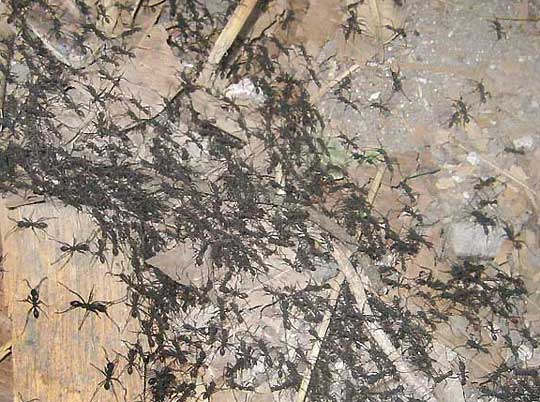Excerpts from Jim Conrad's
Naturalist Newsletter
from the March 31, 2008 Newsletter written in the community of 28 de Junio, in the Central Valley 8 kms west of Pujiltic, elev. ~700m (2300ft), ~N16.331°, ~W92.472°; southeastern Chiapas state, MÉXICO
ARMY ANTS AT DUSK
Wednesday night as I sought my sleeping spot in the reserve I came upon a black, seething mass of army ants. I've told about army ants before, but then I had no camera. Now you can see what I saw that night below:

What's missing in the picture is the movement. The whole mass of ants, which was about the size of a large kitchen table, constantly changed its shape like an amoeba and consisted of several ant streams, some streams flowing in directions contrary to the others. Here and there black knots of ants coagulated and melted away in just seconds, and I figured that these represented "false alarms," something having triggered an attack, but then there was nothing. Though individual ants moved fast, the movement of the whole ant mass was slow, at that time seeming indecisive about which way to go. To get the picture I held the camera as far away from my body as I could, but still a few soldiers on the perimeter climbed my legs and bit.
Basically the idea behind army ants is that as a colony moves across the landscape it stirs up small animals, especially insects, a few of whom always escape in the wrong direction and then the ants quickly dismember them. I've read that army ants have been known to consume animals as large as goats but the largest animal I've ever seen them tear apart was a grasshopper, which disappeared chillingly fast.
In the picture you can see at least two ant sizes. Note how the larger ants usually appear at stream edges. It looks like they're keeping the smaller ants from wandering away from their streams, but who knows?
The site at http://www.insecta-inspecta.com/ants/army/ says that when army ants rest, or "bivouac," they form tunnel-and chamber-containing nests out of nothing but their own bodies. They do this by fastening onto one another with their mandibles (jaws) and claws. The site also says that army ants, though possessing simple eyes, are blind.